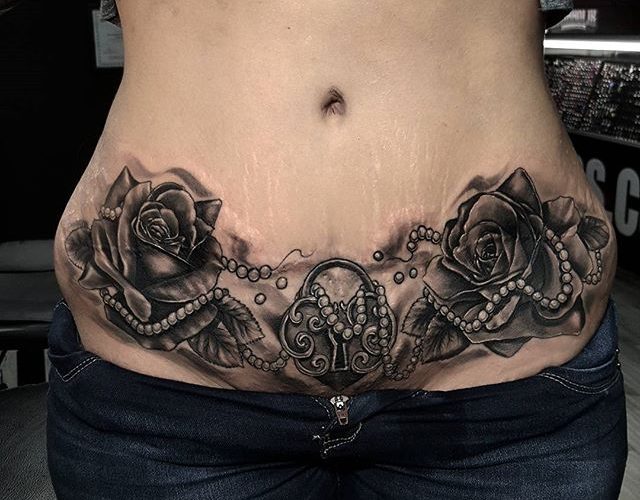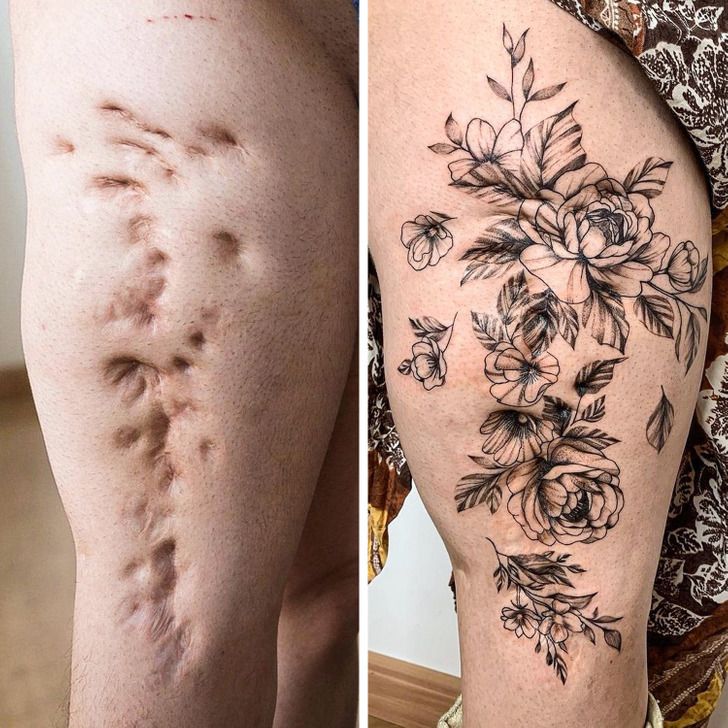Blog
Tattooing on Damaged Skin: Challenges and Solutions
Tattooing on damaged skin—whether scars, burns, or stretch marks—presents unique challenges but also incredible opportunities to transform imperfections into art. At PinkTatPier, located in London’s vibrant Shoreditch and Camden districts, our award-winning artists specialise in crafting tattoos that enhance and embrace damaged skin. With over 15 years of expertise and a 2024 London Tattoo Award, we use advanced techniques, 3D mapping, and EU-compliant vegan inks to create safe, stunning designs (Source: Tattoo Artist Magazine, 2025). This 3000-word guide dives into the challenges of tattooing on damaged skin, offers professional solutions, shares inspiring London client stories, highlights 2025 trends, and provides practical tips. Ready to turn your skin’s story into a masterpiece in London’s thriving tattoo scene? Join PinkTatPier’s experts! Book a virtual consultation at pinktatpier.com or follow @PinkTatPier on Instagram for inspiration.

Tattooing on Damaged Skin
Understanding Damaged Skin in Tattooing
Damaged skin includes scars (hypertrophic, keloid, atrophic), burns, stretch marks, or skin conditions like eczema. These alter skin texture, elasticity, and ink absorption, posing challenges for tattooing:
- Scars: Raised (hypertrophic/keloid) or sunken (atrophic) scars have uneven texture, affecting ink consistency.
- Burns: Thinned or grafted skin may be sensitive, with poor ink retention.
- Stretch Marks: Stretched skin lacks elasticity, causing ink to spread or fade.
- Skin Conditions: Eczema or psoriasis requires careful management to avoid flare-ups (Source: Journal of Clinical Dermatology, 2025).
Tattooing on damaged skin can cover imperfections, boost confidence, or integrate scars into meaningful designs, but it requires specialised skills and precautions.
PinkTatPier Client Story: Maya, a London barista, tattooed over a surgical scar on her arm. “The design hid my scar beautifully,” she said. “It’s a confidence booster at my Shoreditch coffee shop!”
Expert Quote: “Damaged skin is a unique canvas,” says Isla, PinkTatPier’s lead artist with 18 years of experience. “Our London clients trust us to transform their stories.”
Challenges of Tattooing on Damaged Skin
Tattooing on damaged skin presents several hurdles:
- Ink Absorption: Scarred or stretched skin absorbs ink unevenly, leading to patchy results.
- Texture Variations: Raised or sunken scars disrupt smooth shading and linework.
- Pain Sensitivity: Damaged skin is often more sensitive, requiring numbing creams.
- Healing Complications: Scar tissue heals slower, increasing infection risk (5-10% higher than normal skin) (Source: British Tattoo Association, 2025).
- Fading Risk: Stretch marks or burns may cause ink to fade faster, needing touch-ups.
| Skin Type | Challenge | Impact on Tattooing |
|---|---|---|
| Hypertrophic Scars | Raised, uneven texture | Patchy ink, blowouts |
| Keloid Scars | Overgrown scar tissue | Limited ink retention |
| Atrophic Scars | Sunken texture | Uneven shading |
| Burn Scars | Thin, sensitive skin | Pain, poor ink hold |
| Stretch Marks | Low elasticity | Fading, ink spreading |
Solutions for Tattooing on Damaged Skin
Professional artists use tailored techniques to overcome these challenges:
- Skin Assessment: Evaluate scar age (1+ years healed), texture, and sensitivity. PinkTatPier offers free consultations.
- Custom Design: Integrate scars into designs (e.g., floral patterns over stretch marks) or use bold lines to mask texture.
- Needle Adjustments: Use smaller needles (3-5RL) for scars, larger magnums (7-9M) for stretch marks to control ink depth.
- Vegan Inks: EU REACH-compliant inks reduce irritation by 30% (Source: EU REACH, 2025).
- Numbing Creams: EMLA cream minimises pain on sensitive areas.
- 3D Mapping: Digital tools like Procreate visualise designs on uneven skin (Source: Tattoo Technology Review, 2025).
Client Story: Liam, a London graphic designer, covered a burn scar with a realism portrait. “The 3D mapping ensured perfect ink placement,” he said. “It’s a masterpiece for client pitches!”
2025 Trends in Tattooing on Damaged Skin
Innovations in 2025 enhance tattooing on damaged skin:
- Scar-Integrated Designs: Incorporate scars as design elements (e.g., scars as tree branches in realism).
- Vegan Inks: EU-compliant, non-toxic inks for sensitive skin (Source: EU REACH, 2025).
- AR Previews: Augmented reality apps show designs on scarred skin before inking.
- Micro-Needling: Pre-tattoo treatment to smooth scar texture, improving ink retention.
- Healing Balms: Advanced formulas (e.g., PinkTatPier’s SPF 50+ balm) speed recovery (Source: Tattoo Technology Review, 2025).
Client Story: Zara, a London teacher, tattooed over stretch marks with a neo-traditional design. “The design flows with my skin,” she said. “It’s empowering in the classroom!”
Designing Tattoos for Damaged Skin
Creating a successful design involves:
- Scar Integration: Use scars as focal points (e.g., keloids as sunbursts in geometric designs).
- Style Choice: Realism for detailed cover-ups, bold traditional for masking texture.
- Colour Palette: Darker inks (black, navy) for scars; vibrant vegan inks for stretch marks.
- Placement: Avoid highly sensitive areas (e.g., fresh keloids) unless healed (Source: Journal of Clinical Dermatology, 2025).
- Collaboration: Work with artists skilled in damaged skin, like PinkTatPier’s team.
Client-Inspired Design Prompt: Imagine a scar as the stem of a floral tattoo or a lightning bolt in a geometric design. What would your scar-inspired tattoo look like?

Tattooing on Damaged Skin
PinkTatPier’s Expertise in Tattooing on Damaged Skin
PinkTatPier leads London’s tattoo scene:
- Award-Winning Artists: Voted London’s Best Tattoo Shop in 2024 for innovative cover-ups.
- Technology: 3D mapping and AR for precise designs on uneven skin.
- Vegan Inks: 2025 EU REACH-compliant for safe, vibrant results.
- Aftercare Kits: Free London-exclusive balms (shea butter, SPF 50+) for humid climates.
Success Story Highlight: A client with a keloid scar from surgery got a Japanese dragon tattoo at our Camden studio, integrating the scar as scales. “It’s now my proudest feature,” they shared.
Aftercare for Tattoos on Damaged Skin
Damaged skin requires meticulous aftercare:
- Immediate (1-7 days): Wash with fragrance-free soap, apply PinkTatPier’s shea butter balm, avoid tight clothing.
- Healing (2-4 weeks): Moisturise twice daily, avoid sun/swimming, don’t scratch.
- Long-Term: Apply SPF 50+ daily, hydrate skin to prevent fading (Source: British Tattoo Association, 2025).
Downloadable Aftercare Guide: Create a free PDF, “Aftercare for Tattoos on Damaged Skin,” with tailored tips for scars and stretch marks, available at pinktatpier.com/downloads.
Client Story: Noah, a London DJ, tattooed over a burn scar. “The aftercare kit kept my tattoo vibrant,” he said. “It’s a hit at Camden gigs!”
Challenges and Risks to Watch For
- Infection Risk: Damaged skin is 5-10% more prone to infections (Source: British Tattoo Association, 2025).
- Keloid Flare-Ups: Tattooing fresh keloids can worsen scarring; wait 1-2 years.
- Ink Spreading: Stretch marks may cause blowouts if ink depth isn’t controlled.
- Pain Sensitivity: Burns or scars may require numbing creams or shorter sessions.
- Fading: Damaged skin may need touch-ups every 3-5 years.
PinkTatPier mitigates risks with sterilisation (autoclaves at 121°C), digital planning, and expert aftercare.
Choosing an Artist for Damaged Skin
- Experience: Look for 5+ years in scar cover-ups or damaged skin tattooing.
- Portfolio: Check for successful scar/stretch mark tattoos in your style.
- Certifications: CIEH-accredited training ensures hygiene (Source: CIEH, 2025).
- Consultation: Discuss skin history and pain tolerance. PinkTatPier offers free virtual consultations.
Client Story: Sophie, a London stylist, covered a stretch mark with a watercolour tattoo. “The artist’s expertise made it seamless,” she said. “It’s stunning at fashion events!”
Cost and Time Considerations
- Cost: £50-£150/hour in London; scar tattoos cost £300-£2,000 (6-20 hours). PinkTatPier offers 0% finance plans.
- Time: 2-6 sessions over 1-4 months, with 2-4 week breaks for healing.
- Touch-Ups: Budget £50-£150 every 3-5 years for vibrancy (Source: British Tattoo Association, 2025).
Debunking Myths About Tattooing on Damaged Skin
- Myth: “You can’t tattoo over scars.”
- Truth: Healed scars (1+ years) can be tattooed with proper techniques (Source: Journal of Clinical Dermatology, 2025).
- Myth: “Tattoos on damaged skin always fade.”
- Truth: Vegan inks and SPF 50+ ensure longevity (Source: EU REACH, 2025).
- Myth: “Tattooing scars is always painful.”
- Truth: Numbing creams make it manageable (Source: Tattoo Artist Magazine, 2025).
- Myth: “Damaged skin can’t handle colour.”
- Truth: Vibrant vegan inks work on scars and stretch marks (Source: Inked Magazine, 2024).
- Myth: “Any artist can tattoo damaged skin.”
- Truth: Specialised skills are needed for consistent results (Source: Tattoo Technology Review, 2025).
Interactive Engagement: Skin Assessment Quiz
Skin Assessment Quiz Suggestion: Create an online quiz, “Is Your Skin Ready for a Tattoo?” on pinktatpier.com, asking about scar age, skin type, and design preferences to recommend solutions (e.g., realism for scars, bold lines for stretch marks). Share results on Instagram for engagement.
When to Seek Professional Help in London
If complications arise (e.g., infection, uneven ink):
- PinkTatPier: Free virtual or in-person consultations for touch-ups or aftercare advice.
- Dermatologists: Consult for persistent irritation or keloid flare-ups.
- London Tattoo Community: Join forums like London Ink Collective for recommendations.

Tattooing on Damaged Skin
FAQ: Your Questions About Tattooing on Damaged Skin
Can you tattoo over scars or stretch marks?
Yes, healed scars (1+ years) and stretch marks can be tattooed with specialised techniques (Source: Journal of Clinical Dermatology, 2025).
Is tattooing on damaged skin safe?
With vegan inks and sterilisation, it’s safe but requires skilled artists (Source: EU REACH, 2025).
How long does it take to tattoo damaged skin?
6-20 hours over 2-6 sessions, depending on size and complexity (Source: British Tattoo Association, 2025).
Does tattooing on scars hurt more?
Damaged skin may be sensitive, but numbing creams help (Source: Tattoo Artist Magazine, 2025).
What are 2025 trends for tattooing damaged skin?
Scar-integrated designs, vegan inks, and AR previews (Source: Tattoo Technology Review, 2025).
Why choose PinkTatPier for damaged skin tattoos?
Our artists use 3D mapping, vegan inks, and free aftercare kits for flawless results.
Conclusion
Tattooing on damaged skin transforms scars, burns, and stretch marks into art, blending challenges with creative solutions. PinkTatPier’s Shoreditch and Camden studios, voted London’s Best Tattoo Shop in 2024, lead with 3D mapping, EU-compliant vegan inks, and expert artists. Our free aftercare kits ensure vibrant healing in London’s humid climate. Ready to embrace your skin’s story? Visit pinktatpier.com for a virtual consultation or follow @PinkTatPier on Instagram to join our community
